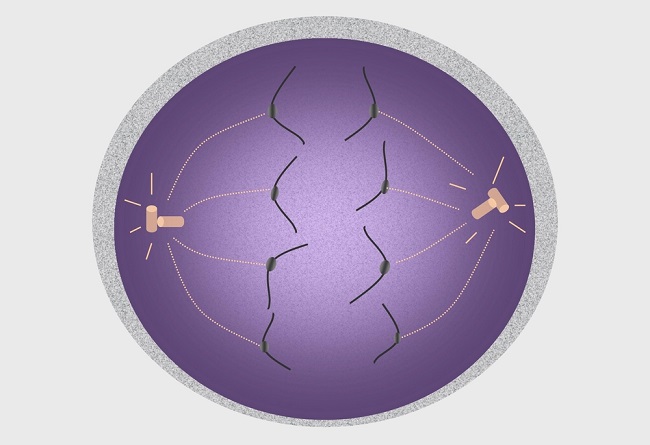What is the shape of DNA?
Double helix
What are the stages of the cell cycle?
Interphase, mitosis, cytokinesis
During prophase of mitosis, what are the four major things that occur?
1) The cell’s chromatin condenses into a compact form called chromosomes
2) Nuclear membrane breaks down
3) Nucleolus disappears
4) Spindle fibres are formed from the centrosomes as they move to opposite poles
What phase of meiosis does homologous chromosomes align (synapsis) and segments of the chromosomes are exchanged.
Prophase I
What makes up the backbone of DNA?
Sugar and phosphate
What happens during interphase?
Phase where a cell grows and replicates its DNA
Draw a labelled diagram of anaphase I. Explain what happens in this phase.

Homologous chromosomes separate and move to opposite poles of the cell. A single chromosome from each homologous pair moves to each pole of the cell
DNA is made up of individual units called __________, which are composed of a ____________, a ____________, and a ____________.
DNA is made ups of individual units called nucleotides, which are composed of a phosphate group, a sugar group and a base.
What is mitosis?
A stage of the cell cycle during which a cell’s nucleus divides and genetic material divides
Explain what happens to the chromosomes, nuclear membrane, and spindle fibres during telophase?
1) Chromosomes start to unwind into strands of less-visible chromatin
2) Spindle fibres breakdown
3) Nuclear membrane forms around the new set of chromosomes
Choose the correct answer:
Meiosis produces
a) Two haploid, genetically unique cells
b) Two diploid, genetically identical cells
c) Four haploid, genetically unique cells
d) Four haploid, genetically identical cells
c) Four haploid, genetically unique cells
State the complementary base pairs.
A - T
C - G
What is cytokinesis?
Division of cytoplasm and creation of new cell
In animal cells - microfilaments pinch the cytoplasm at the equator forming a cleavage furrow until the two cells are separate. Plants cell form a cell plate instead.
True or false. Two diploid cells are formed after meiosis I. Explain your answer.
False. Two haploid cells are formed after meiosis I.
During anaphase I, homologous chromosome pairs separate and move to opposite poles of the cell. This causes the chromosomes # to be reduced from 2n (diploid) to n (haploid)
DNA is double stranded.
If one strand is ATTCGA the other strand would be:
TAAGCT
What is the structure of DNA. during interphase?
The DNA is in very long, thin strands called chromatin
Draw a labelled diagram of anaphase. Explain what is happening in this phase. In your diagram state how many chromosomes are in the cell.
1) Each centromere splits apart and the sister chromatids separate from each other
2) Spindle fibres shorten, pulling the chromosomes to opposite poles of the cell. At the end, one complete set of chromosomes has been gathered at each pole of the cell

In this photo there are 8 chromosomes
Draw labelled diagrams to show prophase II, metaphase II, anaphase II and telophase II
